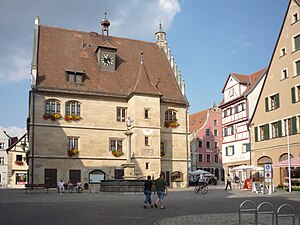Weißenburg is in Middle Franconia. in the Altmühltal Nature Park between the Brombachsee and the Altmühl valley in the Franconian Lake District. Today, the historic townscape with the largely preserved city wall, the Gothic town hall, the town church and the Ellinger Gate bear witness to its time as a trading town and its proximity to wealthy Nuremberg.
Understand
editGet in
editBy train
edit- 1 Train station. Weißenburg has a train station on the main Nuremberg - Treuchtlingen - Augsburg line. The town can also be reached via the Würzburg - Treuchtlingen - Ingolstadt railway line via the neighbouring town of Treuchtlingen, an important railway junction in Bavaria. During rush hour, trains stop in Weißenburg every half hour. Check VGN for schedules and fares.
By car
editWeißenburg is connected to the federal highways B2 (Nuremberg - Augsburg) and B13 (Würzburg - Ingolstadt). The A9 and A6 motorways can be reached via these federal highways within 20 to 30 minutes.
By bicycle
edit- Pleinfeld - Weißenburg - Altmühltal cycle path
- Limes cycle path
- about 10 km south of the Altmühltal cycle path
Get around
editSee
edit



- 1 Wülzburg. A historic fortress about 2 km east of the centre of Weißenburg. It stands on a hill 200 m above Weißenburg, at an elevation of 630.5 m, It was built as a Benedictine monastery in the 11th century. It was converted into a fortress from 1588 to 1605, and is one of the best-preserved Renaissance fortresses in Germany.
- 2 Kastell Biriciana, Am Römerlager 16. Roman fort remains and reconstruction.
- 3 Roman Thermae (Roman baths), Am Römerbad 17a, ☏ +49 9141 907-127, museum@weissenburg.de. 15 Mar-15 Nov: 10:00-17:00. They were probably built by legionaries as a civilian bath. The well-preserved foundations and reconstructed rooms give an impression of the typical Roman bathing facilities. The complex, discovered in 1977 and converted into a museum in 1983, is one of the largest in southern Germany. Adults €4; children €1.
- 4 RömerMuseum (Roman Museum), Martin-Luther-Platz 3-5. Tu-Su 10:00-12:30, 14:00-17:00. Finds from numerous excavations in the Weissenburg area illustrate the long history. The highlight of the exhibition is the Roman treasure, which was buried between 233 and 259/60 because of impending danger and only rediscovered in 1979 in an asparagus bed. The most valuable of the statuettes is the Hercules statuette. The Roman treasure contains a total of around 150 individual pieces, 17 of which are bronze statuettes, making the Roman treasure the largest treasure find in Germany. Adult €6.00, child (6 to 16 years) €1.50, child under 6 free.
Do
editBuy
editAround the whole city you will find supermarkets called Aldi, Marktkauf, Norma, Penny.
In the old city of Weißenburg you will find clothes stores, bakeries and Turkish fast food stores.
Eat
editLots of traditional restaurants around. The quality of food is generally quite high. Main courses about €8-15, half liter of beer for €3-5.
- Al Forno Ristorante, Nördliche Ringstraße 37, ☏ +49 9141 920420.
- Andreas Stuben, Rosenstraße 18, ☏ +49 9141 8737919, fax: +49 9141 8737920.
- Antichi Sapori Romani, Judengasse 25, ☏ +49 9141 9239172.
- Bräustüberl Zur Kanne, Bachgasse 15, ☏ +49 9141 3844. Tu-So 10.30–14.00 and 17.30–24.00. Original interior nearly untouched since 1890.
- Hotel Restaurant Goldener Adler, Marktplatz 5, ☏ +49 9141 85560, fax: +49 9141 855633.
- Hotel Restaurant Schwarzer Bär, Marktplatz 13, ☏ +49 9141 92426, fax: +49 9141 92443.
- Löwengarten Restaurant, Westliche Ringstr. 36, ☏ +49 9141 8731963. Greek and German food.
- Mai Thai, Bismarckanlage 16, ☏ +49 9141 995759.
- Steakhaus El Toro, Obertorstr. 5, ☏ +49 9141 922730.
- Silbermühle - vino y tapa Restaurant, Silbermühle 4, ☏ +49 9141 9744001, silbermuehle@web.de.
Drink
edit- 1 Bräustüberl Zur Kanne, Bachgasse 15, ☏ +49 9141 3844. Tuesday to Sunday from 10.30 - 14.00 and 17.30 - 24.00, Monday rest day. This inn could also be among sights, the guest room is essentially in the state of 1890.

Sleep
edit- Flair Hotel Am Ellinger Tor, Ellinger Str. 7,, ☏ +49 9141 86460.
- Hotel-Gasthof Schwarzer Bär, Marktpl. 13, ☏ +49 9141 92426.
Connect
editGo next
edit- Brombachsee lake with three parts in the North with lots of spare time activities.
- Gunzenhausen with nearby Altmühlsee
- Altmühl nature reserve
- Altmühl valley
- Pappenheim
- Dollnstein
- Eichstätt
- Fossa Carolina is a former 3 km long channel between Altmühl and the Rezat built in 793 near Treuchtlingen. It effectively connected the river systems of the Rhein heading to the North sea with the Danubian river system going to the Black Sea. This was the first of three attempts to connect the two rivers (a later one in the 19th century failed due to competition from railways, the current one dates to 1992).


